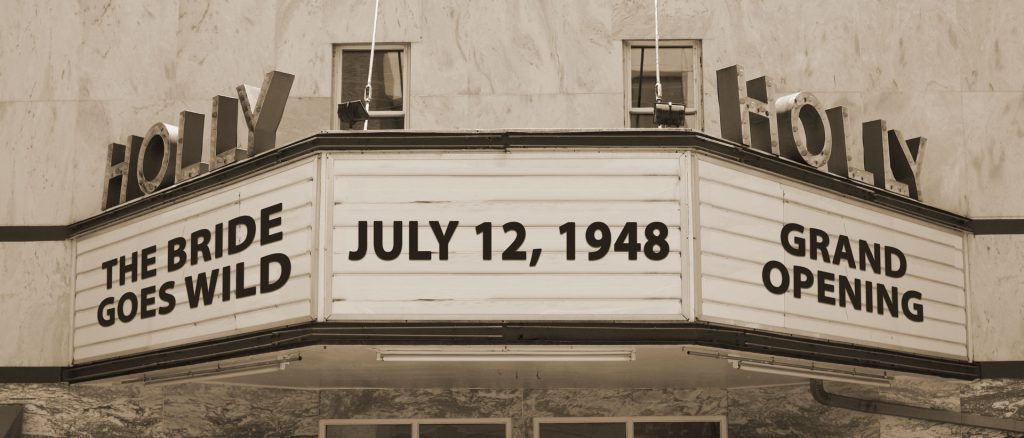Dahlonega’s Gold History Attracts Fox Film Company
Around 1915 Dahlonega began being used for Hollywood Motion Pictures by Fox Film Company. They used an abandoned gold mine in their production “The Plunder” based off a novel by Roy North. Other silent movies that were shot in Dahlonega included “Big Jim Garrity” by Pathe Feres Company, “The Great Divide” filmed at Preacher Cut on Crown Mountain,”Driven”in the 1920s by Brabin Productions, and “The Daughter of Devil Dan” by Buffalo Pictures.
Finally the city decided that if movies could be made in their area they should be shown. Silent movies were shown in a courtroom in the courthouse and in the Price Memorial Auditorium. In the mid 1920’s Robert D. Howser Sr. converted the lower floor of the Price Building into a theater and began showing films.
“The Price Building” Opens as A Theatre
In 1939 Mr. Randall Holly Brannon leased the Price Building. He added a ticket booth, an awning, double doors, and large THEATRE sign. The opening film was showing April 17, 1939 titled “Stagecoach” staring Marion Morrison or later known as John Wayne. Since Brannon’s wife ran their theater in Roswell and Brannon had to stay in Dahlonega to run this one he stayed at the Smith House in Room 1 for years.
Dahlonega Theater Closes
In January 9, 1943 Dahlonega Theater temporarily closed due to a fire destroying the adjoining building. The destroyed building had been an old hotel turned into a dorm for the North Georgia students. At the end of WWII Brannon decided Price was not an adequate space and applied to build a new theater. He was denied in September 1946. The Civilian Production Administration (CPA) was supposed to expire on March 31, 1947 so Brannon broke ground and began building his theater. Instead of the CPA being expired, its control was transferred to another governmental department. There were numerous construction and repairs needed in the county and this theater was using the much needed material, so on May 16, 1947 Brannon was ordered to halt construction immediately.
After many letters written to congress written by citizens and other powerful officials explaining the situation that all the material for the Holly has been purchased and is sitting deteriorating. There were enough workers and this project was not interfering with any other projects. And so, in December 1947 Brannon’s application was finally approved.
The Holly Theater Officially Opens
On July 12, 1948 the Holly Theater celebrated its grand opening! The featured film was MGM’s “The Bride Goes Wild”. It was as it is now. A sold brick building with a Georgia Marble facade. The interior was covered with fabric and the matching curtain was electrically operated. The theater held 500. A lady named Mrs. Ash ran the ticket booth. She just loved the movies and loved helping out. She became such a trusted employee that Brannon let her manage things and he was able to spend more time with his wife.

The theater did well through the 1950s but into the 1960s people began to turn to television. Attendance dropped and when Mr. Brannon died in 1965 his wife tried to keep the theater alive. Money became tight and she raised admission to 75 cents due to lack of knowing what else to do. She cut off the water in 1970s for many reasons but her main one was for the freezing cold weather. People rented the building for various events but in 1976 J.L. Proctor reopened the theater but by November 1979 the theater was again closed. In 1980 the building was used to house worship by the Harvest Bible Church.
Eventually, after all this, the building began to deteriorate. Weeds grew on it and it was in and out used but not taken care of. The building has now been restored and shows movies and plays. it isn’t open all the time but there are weeks that the Holly show various types of entertainment. It is now a well known and loved place to college students, Dahlonega citizens and theater-goers in neighboring communities.
July 1948
Holly Theatre opens as a movie house by Randall Holly Brannon.
1970-1979
Theatre closes. Temporary tenants, several revival attempts as a movie theatre follow. Problems with flat-roof leakage begin. Eventually, a full closure results. Over time, building falls into total disrepair.
1990-1993
Group of concerned citizens negotiates the purchase of the building; forms a non-profit corporation, Holly Theatre Community Center, Inc.; begins successful fund raising from a broad section of Dahlonega/Lumpkin County community; invests thousands of hours of volunteer labor for clean up; begins building restoration. Every effort is made to preserve historic authenticity, including the original marquee and the façade of local marble.
November 1993
Holly Theatre opens with The Mountain Music Night, a benefit performance.
1994
First full production presented, Driving Miss Daisy, by local amateur community group The Holly Players.
1994-1998
Success continues with a couple of local productions per year of musicals and plays, augmented by bringing back the movies. The Children’s Theatre program begins for local youth. Basement is cleaned up, dirt floor leveled and concrete poured to make the space usable (now known as the Black Box). Players reemerge as the Holly Theatre Company, a name retained to this day.
1999
A regular season is established of community theater productions, movies and occasional concerts.
2002
Holly Theatre receives the recognition of a listing on the National Register of Historic Places. It becomes integral part of the Downtown Historic District, contributing to business and tourism development.
2000-2010
Theater grows into a popular venue. Great community support enables the leadership to pay off the 20-year purchase note ahead of time and secures a revolving bank loan to finance productions. Late in the decade, new Boards of Directors become less community oriented, hire more staff, and borrow larger sums in the face of post-recession economy and slow recovery, leading to financial instability.
2011
Experiments with more contemporary plays and fewer musicals add to the theatre’s economic woes. One source of income, the movies, has to be discontinued because of industry transition to unaffordable digital projectors.
2012
Critical year in the life of the theatre: the indebted Holly is required by the bank to provide the property as collateral. Maintenance issues of the building become very pressing. In response to financial pressure, all staff is laid off. Board resignations, show cancelations and temporary closing of the theatre follow during the summer.
Revival
An angel steps in to take over the mortgage payments for a year. A skeletal Board reaches out to the community in a well-attended town hall meeting to call for early board elections and to outline a business plan that will rely on strictly volunteer-run model. By the fall of 2012, like the legendary Phoenix, Holly Theatre re-emerges with new popular productions. Soon, all vendors can be paid, and a well-subscribed 2013 theatre season is announced.
2013
The community is engaged again and the theatre thrives. Raise the Roof campaign successfully garners funds to replace the original, leaky roof and to install more efficient down spouts. Stage lighting and sound systems are also improved. The management contracts with a professional marketing firm, resulting in growing audiences and a more solidly recognized brand. The theatre can celebrate a great 20th Anniversary.
2014
Having stabilized the building, the theatre applies for the Fox Theatre Institute (FTI) Preservation Grant and partners with The Dahlonega Downtown Development Authority for the FY 2015 Tourism Product Development Grant, to be matched by the Holly’s fund raising.
2015
Grants and matching funds successfully in place, the theatre completes external renovations: re-pointing the brick walls and repairing the marble façade and re-wiring the original marquee with energy-efficient LED lights.
2016-2018
As it celebrates its Silver Anniversary and beyond, the Holly Theatre Community Center continues to serve as a beloved performance venue and a heart of the community. It relies on countless volunteers to run all aspects of its operations. A matching FTI Planning Grant is received to help improve interiors and production values.
2019
Solid financial footing is reached to ensure long-term viability. Another FTI grant pays for architectural plans (Jeff Crocker, BCA Studios of Gainesville) for stage, safety and HVAC enhancements. Capital fundraising for these renovations is launched: ELEVATE! Holly Theatre Campaign for New Stage Magic: Taking Holly Shows from Great to Amazing!
2020-2023
Two federal grants (ARC and USDA-RBDG) and a major challenge grant (MI Holdings) provide nearly half of the needed funds; internal renovations are carried out during the closure forced by COVID-19 restrictive measures. The community rallies once more to complete a record $650,000 campaign goal to complete the project. The Holly starts coming back with small summer previews and concerts. The grand reopening is on October 22, 2021, with the Disney musical Beauty and the Beast. A short season ends with nearly sold-out performances of The Sound of Music and the new, full 2022-2023 Season is announced, themed ‘Hope Endures and Love Conquers All.’ 2023 marks our milestone Anniversaries: 75 years of the Holly Theatre, 30 years of the Holly Theatre Community Center.
Want more?
Visit the Holly’s dedicated history website for past show details, famous people of the Holly and more.



